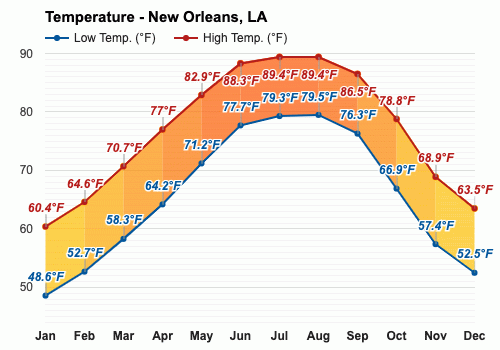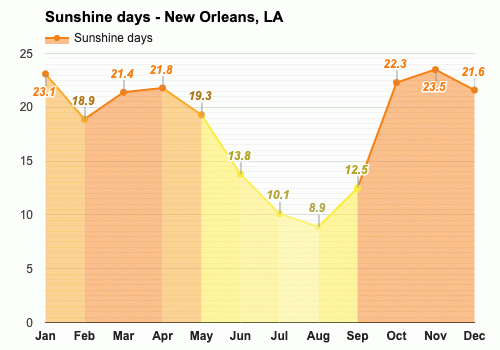Contents
- The climate of New Orleans
- The best time to visit New Orleans
- The worst time to visit New Orleans
- Spring weather in New Orleans
- Summer weather in New Orleans
- Autumn weather in New Orleans
- Winter weather in New Orleans
- Weather in January
- Weather in February
- Weather in March
- Weather in April
- Weather in May
- Weather in June
- Weather in July
- Weather in August
- Weather in September
- Weather in October
- Weather in November
- Weather in December
- Frequently asked questions
- Average temperature
- Average pressure
- Average wind speed
- Average humidity
- Average rainfall
- Average rainfall days
- Average snowfall days
- Average daylight
- Average sunshine
- Average sunshine days
- Average UV index
- Average cloud cover
- Average visibility

Climate and monthly weather forecast
The climate of New Orleans
Distinct variations can be noted in the weather parameters year-round. High temperatures in New Orleans range from 60.4°F (15.8°C) in January to a peak of 89.4°F (31.9°C) in both July and August. Meanwhile, low temperatures exhibit a similar trend, registering at 48.6°F (9.2°C) in January and peaking at 79.5°F (26.4°C) in August. The city experiences a relatively high humidity level year-round, averaging between 72% to 77% in all twelve months.
Rainfall in New Orleans varies considerably across the year. The driest month is March, with an average precipitation of 0.43" (11mm), while the wettest month is July, receiving up to 1.57" (40mm) of rain on average. Additionally, the city enjoys long daylight hours throughout the year, peaking at 14.1 hours in June before decreasing to 10.2 hours in December. The city's wind speed ranges from 6.6mph (10.6km/h) to 9.8mph (15.8km/h), with the strongest gusts being experienced in December at 14.5mph (23.3km/h).
The best time to visit New Orleans
The worst time to visit New Orleans
Spring weather in New Orleans
Summer weather in New Orleans
Autumn weather in New Orleans
Winter weather in New Orleans
Weather in January
Weather in February
Weather in March
Weather in April
Weather in May
Weather in June
Weather in July
Weather in August
Weather in September
Weather in October
Weather in November
Weather in December
Published by: Weather U.S. | About Us
Data Sources | Weather Forecasting & Climate
Frequently asked questions
What time of the year is the coldest?
How many days does it rain?
When does it snow?
When does it snow the most?
How many days does it snow?
What is the most humid month?
When it does not snow?
What is the driest month?
When is Daylight Saving Time (DST)?
When is the highest UV index?
When are the longest days?
What month has the most sunshine?
What time of the year is the hottest?
What is the wettest month?
What is the least humid month?
What is the month with the shortest days?
What is the month with the least sunshine?
When is the lowest UV index in New Orleans?

Average temperature
New Orleans, LA
The warmest months (with the highest average high temperature) are July and August (89.4°F).
The month with the lowest average high temperature is January (60.4°F).
The month with the highest average low temperature is August (79.5°F).
The coldest month (with the lowest average low temperature) is January (48.6°F).

Average pressure
New Orleans, LA
- Average pressure in January:
30.16"Hg - Average pressure in February:
30.11"Hg - Average pressure in March:
30.09"Hg - Average pressure in April:
30"Hg - Average pressure in May:
29.99"Hg - Average pressure in June:
29.97"Hg
- Average pressure in July:
30.01"Hg - Average pressure in August:
29.97"Hg - Average pressure in September:
29.97"Hg - Average pressure in October:
30.02"Hg - Average pressure in November:
30.12"Hg - Average pressure in December:
30.12"Hg
The month with the highest atmospheric pressure is January (30.16"Hg).
The months with the lowest atmospheric pressure are June, August and September (29.97"Hg).

Average wind speed
New Orleans, LA
- Average wind speed in January:
9.6mph - Average wind speed in February:
9.8mph - Average wind speed in March:
9.6mph - Average wind speed in April:
9.8mph - Average wind speed in May:
8.2mph - Average wind speed in June:
7.3mph
- Average wind speed in July:
6.6mph - Average wind speed in August:
6.7mph - Average wind speed in September:
7.1mph - Average wind speed in October:
8.4mph - Average wind speed in November:
9mph - Average wind speed in December:
9.4mph
The windiest months (with the highest average wind speed) are February and April (9.8mph).
The calmest month (with the lowest average wind speed) is July (6.6mph).

Average humidity
New Orleans, LA
The months with the highest relative humidity are February and December (77%).
The month with the lowest relative humidity is October (71%).

Average rainfall
New Orleans, LA
- Average rainfall in January:
0.47" - Average rainfall in February:
0.55" - Average rainfall in March:
0.43" - Average rainfall in April:
0.43" - Average rainfall in May:
0.75" - Average rainfall in June:
0.87"
- Average rainfall in July:
1.57" - Average rainfall in August:
1.46" - Average rainfall in September:
0.47" - Average rainfall in October:
0.94" - Average rainfall in November:
0.63" - Average rainfall in December:
0.79"
The wettest month (with the highest rainfall) is July (1.57").
The driest months (with the least rainfall) are March and April (0.43").

Average rainfall days
New Orleans, LA
- Average rainfall days in January:
5.8 days - Average rainfall days in February:
7.1 days - Average rainfall days in March:
8.3 days - Average rainfall days in April:
6.7 days - Average rainfall days in May:
8.6 days - Average rainfall days in June:
11.9 days
- Average rainfall days in July:
15.5 days - Average rainfall days in August:
17.2 days - Average rainfall days in September:
11.7 days - Average rainfall days in October:
6.8 days - Average rainfall days in November:
4.7 days - Average rainfall days in December:
7.8 days
The month with the highest number of rainy days is August (17.2 days).
The month with the least rainy days is November (4.7 days).

Average snowfall days
New Orleans, LA
- Average snowfall days in January:
0.1 days - Average snowfall days in February:
0 days - Average snowfall days in March:
0 days - Average snowfall days in April:
0 days - Average snowfall days in May:
0 days - Average snowfall days in June:
0 days
- Average snowfall days in July:
0 days - Average snowfall days in August:
0 days - Average snowfall days in September:
0 days - Average snowfall days in October:
0 days - Average snowfall days in November:
0 days - Average snowfall days in December:
0 days
The month with the highest number of snowfall days is January (0.1 days).
The months with the least snowfall days are February, March, April, May, June, July, August, September, October, November and December (0 days).

Average daylight / Average sunshine
New Orleans, LA
- Average daylight in January:
10h and 3min - Average daylight in February:
11h and 1min - Average daylight in March:
12h and 0min - Average daylight in April:
12h and 5min - Average daylight in May:
13h and 4min - Average daylight in June:
14h and 0min
- Average daylight in July:
13h and 5min - Average daylight in August:
13h and 1min - Average daylight in September:
12h and 2min - Average daylight in October:
11h and 2min - Average daylight in November:
10h and 4min - Average daylight in December:
10h and 2min
The month with the longest days is June (Average daylight: 14h and 0min).
The month with the shortest days is December (Average daylight: 10h and 18min).
- Average sunshine in January:
5h and 4min - Average sunshine in February:
5h and 2min - Average sunshine in March:
7h and 5min - Average sunshine in April:
9h and 5min - Average sunshine in May:
10h and 4min - Average sunshine in June:
11h and 0min
- Average sunshine in July:
10h and 4min - Average sunshine in August:
10h and 4min - Average sunshine in September:
10h and 1min - Average sunshine in October:
7h and 2min - Average sunshine in November:
6h and 1min - Average sunshine in December:
5h and 1min
The month with the most sunshine is June (Average sunshine: 11h and 0min).
The month with the least sunshine is December (Average sunshine: 5h and 6min).

Average sunshine days
New Orleans, LA
- Average sunshine days in January:
23.1 days - Average sunshine days in February:
18.9 days - Average sunshine days in March:
21.4 days - Average sunshine days in April:
21.8 days - Average sunshine days in May:
19.3 days - Average sunshine days in June:
13.8 days
- Average sunshine days in July:
10.1 days - Average sunshine days in August:
8.9 days - Average sunshine days in September:
12.5 days - Average sunshine days in October:
22.3 days - Average sunshine days in November:
23.5 days - Average sunshine days in December:
21.6 days
The month with the most sunshine days is November (23.5 days).
The month with the least sunshine days is August (8.9 days).

Average UV index
New Orleans, LA
The months with the highest UV index are May, June, July, August and September (UV index 7).
The month with the lowest UV index is December (UV index 3).

Average cloud cover
New Orleans, LA
The month with the most cloud cover is December (Cloud cover 44).
The month with the least cloud cover is October (Cloud cover 24).

Average visibility
New Orleans, LA
The months with the highest visibility are January, February, March, April, May, June, July, August, September, October, November and December (6mi).
The months with the lowest visibility are January, February, March, April, May, June, July, August, September, October, November and December (6mi).